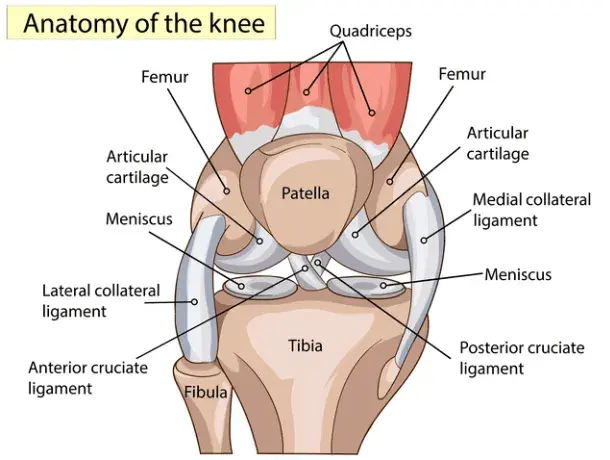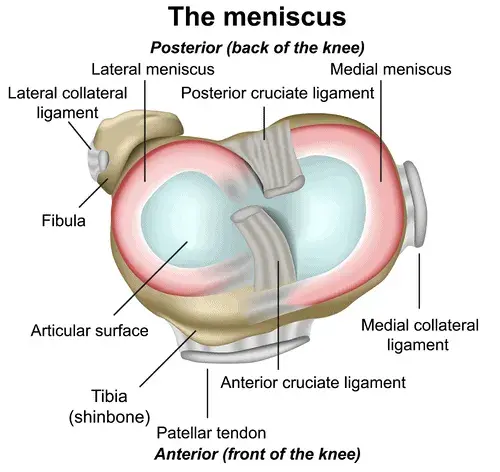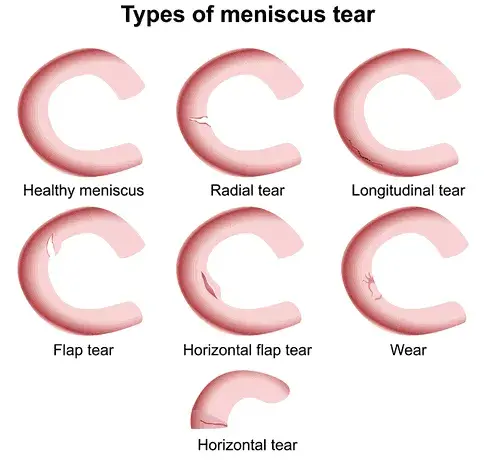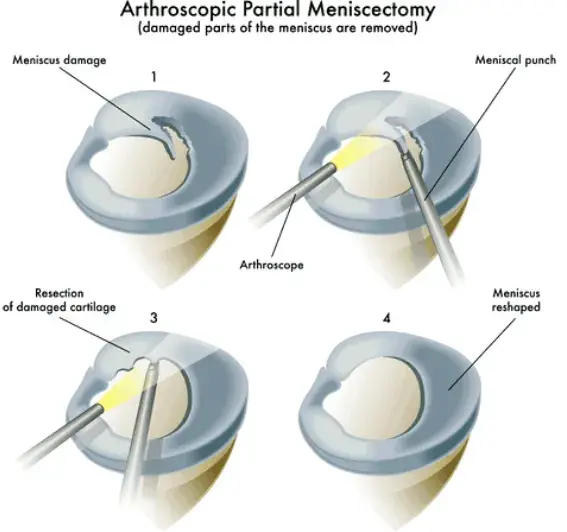Meniscus Tear Recovery Time Without Surgery – Ospina Medical – New York, NY
The meniscus is a C-shaped cartilage structure in the knee that helps cushion the area between the thigh bone (femur) and shinbone (tibia). Tears can result from injury or age-related degeneration, often causing pain, swelling, and joint instability.
Although surgery is commonly recommended, research indicates that approximately 41.3% of meniscus tears occur in the “red zone” a region with greater blood supply that may allow for natural healing.
Procedures using Regenexx injectates apply interventional orthobiologic techniques to support this healing potential, providing a less invasive alternative to surgery aimed at improving knee function and joint health.
What Is A Torn Meniscus?
The knee is a complex joint where the thigh bone (femur), shinbone (tibia), and kneecap (patella) meet. Stability and movement are supported by surrounding ligaments and tendons, which help manage the distribution of force and load throughout the joint.

Several soft tissue structures help protect the bones within the knee joint by reducing friction and absorbing impact. Among these are the menisci, two C-shaped cartilage discs located between the femur and tibia. Each knee contains a medial meniscus on the inner side and a lateral meniscus on the outer side.
The menisci function as shock absorbers, helping to distribute weight evenly across the knee during activities such as walking, running, or jumping. They also contribute to joint stability and assist with smooth, controlled motion.
A meniscus tear occurs when the fibrous cartilage is damaged, often as a result of a sudden twist or impact. These types of injuries are common in sports or activities that involve rapid direction changes or physical contact.
Meniscus degeneration can also occur gradually with age. Repetitive movement and prolonged joint stress may wear down the cartilage over time, increasing the likelihood of tearing.
When the meniscus is torn, its fibrous structure may separate, forming irregular edges that can become caught within the joint. This may result in pain, swelling, and a sensation of instability, such as the knee locking or giving way.

Meniscus tears are estimated to affect up to 14% of the population, particularly athletes and older adults, and are involved in approximately 50% of all reported knee injuries
Types Of Tears In The Meniscus
Meniscus tears are graded based on their severity and the intensity of symptoms. Grade 1 tears are mild and may result in minimal discomfort. Grade 3 tears are more severe, often involving a full tear, and may lead to pronounced pain, swelling, and limited range of motion in the knee.
Tears can also be classified by their location within the meniscus and the pattern or shape of the damage.

Intrasubstance Tear (Incomplete)
This type of tear occurs within the interior of the meniscus cartilage and typically does not extend to its surface. Intrasubstance tears are frequently associated with age-related degeneration. They may not produce immediate symptoms but can gradually worsen over time.
Horizontal Tear (Longitudinal)
A horizontal tear follows a path parallel to the tibial plateau, effectively dividing the meniscus into upper and lower segments. These injuries often result from shear stress, such as twisting motions that pull different layers of cartilage in opposing directions.
If the tear progresses, it may develop into more complex patterns, such as flap or bucket-handle tears, that are more likely to cause symptoms.
Radial Tear (Transverse)
Radial tears originate at the inner edge of the meniscus and extend outward. They disrupt the circumferential collagen fibers that help distribute load and provide mechanical strength to the structure. Damage to these fibers often leads to joint instability and impaired knee function.
Flap Tear
In a flap tear, a portion of the meniscus becomes displaced, creating an uneven segment that may catch within the joint during movement. These injuries are often symptomatic, commonly producing discomfort, mechanical clicking, or locking sensations in the knee.
Bucket-Handle Tear
One of the more common meniscus injuries, bucket-handle tears, account for over 30% of cases. This type of longitudinal tear occurs when a fragment of the meniscus is displaced into the joint, forming a shape that resembles a bucket handle.
These tears frequently result from forceful knee twisting or awkward landings, especially in athletic activities. They often lead to joint locking and restricted range of motion.
Complex Tear
Complex tears involve multiple tear patterns in the same meniscus, such as combinations of horizontal, radial, and oblique components. These injuries are typically the result of significant trauma or advanced degeneration and may occur alongside other joint injuries, including ACL tears. Treatment can be more challenging due to the mixed nature of the damage.
Oblique Tear
Oblique tears run diagonally across the meniscus and often occur due to rapid directional changes or twisting movements. These injuries can result in loose cartilage fragments that cause discomfort, swelling, and joint locking. Oblique tears may overlap with other patterns, which can make diagnosis and treatment planning more complex.
Symptoms Of A Torn Meniscus
Individuals with a meniscus tear may experience discomfort, swelling, or mechanical issues in the knee. Symptoms can vary—some people may notice persistent or occasional pain, while others may not experience any symptoms at all. In cases where the tear does not result in joint locking, many individuals are still able to carry out normal daily activities without significant discomfort.
Pain Along The Joint Line
Discomfort along the line where the femur and tibia meet is a common indicator of a meniscus tear. Several factors may contribute to this symptom:
- Nerve Sensitization: Injury to the knee may affect nearby nerves, sending pain signals to help protect the joint from further stress.
- Inflammatory Response: Inflammation triggered by the injury leads to the release of certain chemical messengers, such as prostaglandins and cytokines, that increase sensitivity and may cause redness, swelling, and pain.
- Chronic Inflammation: While inflammation usually decreases as healing progresses, in some cases it may continue at low levels, resulting in long-term discomfort. Contributing factors can include a history of knee injury, higher body mass index, repetitive joint strain, older age, or female sex.
A study found that 61% of individuals with meniscus tears did not report pain, aching, or stiffness. However, there are several symptoms that may suggest a meniscus tear and warrant further evaluation:
- Swelling Or Stiffness In The Knee: Swelling also called effusion, can occur when inflammation causes the body to retain fluid in the joint space. This fluid buildup typically begins within a few hours of injury and may increase pressure in the knee, leading to stiffness, limited motion, and warmth around the joint.
- Feeling As If The Knee Is Collapsing Under Its Own Weight: Joint instability may present as a sensation of the knee giving out or buckling, especially when changing direction or bearing weight. This is often due to a compromised meniscus, which limits proper load distribution and joint control during movement.
- Knee Popping After Injury: A popping sensation in the knee after an injury may indicate ligament damage, a meniscus tear, or cartilage issues. It may be accompanied by pain, swelling, or instability, depending on the severity of the injury. Read More About Knee Popping After Injury.
- Can’t Straighten Knee: Difficulty fully extending the knee may be due to joint stiffness, a meniscus tear, ligament injury, or arthritis. It can cause discomfort, swelling, or a locking sensation, limiting mobility and daily activities. Read More About Can’t Straighten Knee.
- Knee Locking Up: Knee locking may result from a meniscus tear, cartilage damage, or joint inflammation, causing temporary immobility or stiffness. It can make bending or straightening the knee difficult, sometimes accompanied by pain or swelling. Read More About Knee Locking Up.
What Causes The Meniscus To Tear?
Meniscus tears are commonly classified as either acute or degenerative.
Acute tears typically result from a sudden injury, such as a forceful twist or impact to the knee. Degenerative tears, on the other hand, develop gradually over time and are associated with the natural aging process, which can weaken the meniscus and increase its vulnerability to tearing.
Knee Injuries
Trauma to the knee is one of the primary causes of meniscus damage. These injuries may occur in a variety of ways:
- Sports-related injuries: A significant number of acute meniscus tears happen during athletic activity—especially in sports that require pivoting, abrupt stops, or physical contact, such as football, basketball, or soccer. Non-contact activities like tennis or skiing may also contribute due to rapid directional changes.
- Twisting or rotational forces: The meniscus can tear when different sections of the cartilage are subjected to opposing forces, such as during sharp turns, pivoting, or awkward landings. These movements may exceed the meniscus’s ability to withstand strain, resulting in injury.
Meniscus tears often occur in conjunction with other injuries, particularly anterior cruciate ligament (ACL) tears. Research has shown that individuals with an ACL injury have a significantly increased risk, between 22% and 86%, of developing a subsequent meniscus tear.
Aging
The aging process can affect various joint components, including the meniscus. As the body’s natural regenerative capacity declines over time, the meniscus may become thinner, less resilient, and more prone to wear-related injury.
While age-related degeneration is common, certain factors may accelerate this process:
- Higher body weight
- Tobacco use
- Activities or occupations that involve repetitive knee stress (e.g., lifting, jumping, pivoting)
- Poor alignment or posture
- Structural variations in the knee, such as:
- Naturally thin cartilage
- Bowed legs (genu varum) or knock-knees (genu valgum)
Chronic conditions like osteoarthritis may also increase the likelihood of meniscal damage. Studies have shown that 60% to 90% of individuals with osteoarthritis display MRI evidence of meniscus tears.
Can A Torn Meniscus Heal On Its Own?
Yes, the meniscus is made up of living tissue, and certain areas have strong blood supply, which makes healing more likely in those regions.
Several factors can influence the healing potential of a meniscus tear:
- Location of the Tear: The meniscus is divided into three vascular zones: red, red-white, and white. The likelihood of healing depends on where the tear occurs.
- Red zone: Located on the outer edge, this area has a rich blood supply and is generally capable of healing on its own.
- Red-white zone: This intermediate region has limited blood flow. Healing is slower but still possible.
- White zone: Found on the inner portion of the meniscus, this area has minimal to no blood supply, making natural healing less likely. Tears in this region may require additional treatment.
- Size of the Tear: Smaller tears, especially those not involving fragments or joint locking, tend to heal more successfully. Larger or more complex tears may restrict movement and limit circulation, reducing the chances of natural recovery.
- Other Contributing Factors: Healing may also be affected by a person’s age, history of previous meniscus or knee injuries, and the presence of joint conditions such as osteoarthritis.
Physical therapy may help promote recovery. However, the body may require additional support to optimize healing. Procedures using Regenexx interventional orthobiologics are designed to assist the body’s natural repair processes, particularly when healing is incomplete or delayed
Meniscus tear recovery without surgery
Conventional Treatment Recommendations For A Torn Meniscus
Conventional approaches for addressing a torn meniscus are designed to help reduce discomfort and enhance joint mobility. When the tear is more extensive, additional treatment options may be considered by a physician in Ospina Medical, New York.
- RICE Method: The RICE method—rest, ice, compression, and elevation is often recommended early in care. Rest helps limit additional strain, while ice may assist in managing swelling. Compression using a brace or wrap may offer added support. Elevation helps minimize fluid buildup, which may reduce swelling. Though widely used, recent findings suggest that prolonged icing and limited blood flow at the injury site could potentially delay recovery..
- Non-Steroidal and Inflammatory Drugs (NSAIDs): Nonsteroidal anti-inflammatory drugs (NSAIDs) help reduce pain and inflammation in conditions affecting joints, muscles, and the spine. While they provide temporary relief, prolonged use may increase heart, kidney, and gastrointestinal risks, requiring careful management. Read More About NSAIDs.
- Surgical Options for Meniscus Tears: Surgical intervention may be explored if other approaches have not provided adequate relief or if the tear significantly interferes with joint function. Physicians in the licensed Regenexx network may consider several surgical procedures when appropriate:
- Partial meniscectomy: The damaged portion of the meniscus may be removed to reduce mechanical symptoms and improve mobility.
- Meniscus repair: In this procedure, the torn areas of the meniscus are stitched together to support natural healing and preserve as much of the original tissue as possible.
- Meniscus transplantation: In cases where the meniscus has been severely damaged or removed, a donor meniscus may be implanted to help restore cushioning within the joint.

These surgical procedures are complex and may involve notable risks, such as infection, blood clots, or injury to surrounding knee structures. Research has also indicated that approximately 19% of meniscus surgeries may not achieve long-term success, with some individuals requiring additional surgical intervention within five years.
Why Consider Avoiding Meniscus Surgery?
Studies have suggested that surgical procedures for meniscus tears may be frequently recommended even when conservative care could offer similar outcomes. In some cases, surgery has not shown greater benefit than structured physical therapy. Patients are not always made aware of the potential for modest success rates associated with these interventions.
Whether involving partial removal of damaged tissue or a full meniscectomy, these procedures may change the natural mechanics of the knee joint and have been associated with an increased likelihood of developing knee osteoarthritis over time.
Torn Meniscus Recovery Time Without Surgery
Recovery following knee surgery may extend over several months and can involve uncomfortable rehabilitation to restore strength and function. The duration of recovery often depends on factors such as the nature of the tear, the procedure performed, and the individual’s overall health. Research has shown that recovery outcomes may be more limited following knee replacement compared to knee arthroscopy.
Procedures using Regenexx injectates offer a non-surgical alternative that may support the meniscus’s role in cushioning the knee joint. These procedures are associated with shorter recovery periods than traditional surgery. Many individuals are able to resume daily activities within weeks and may gradually return to more physically active routines, including sports, within a few months.
635 Madison Ave
Suite 1301
New York, NY 10022
Request an Appointment
Call to Schedule Schedule OnlineClinic Hours
| Sunday | Closed |
| Monday | 9AM–5PM |
| Tuesday | 9AM–5PM |
| Wednesday | 9AM–5PM |
| Thursday | 9AM–5PM |
| Friday | 9AM–5PM |
| Saturday | Closed |
How Does Regenexx Work For Meniscus Tears?
At Regenexx, we invented a new approach to orthopedic care we call Interventional Orthopedics. This minimally invasive alternative to meniscus surgery uses ultrasound-guided technology to precisely inject your own bone marrow concentrate — which contains stem cells — directly where it’s needed in the joint.
The cells in your bone marrow concentrate work at the site of your injury to promote your body’s natural healing abilities to treat the tear and avoid surgery1.
Meniscus Tear Recovery Time Without Surgery
In most cases, knee surgeries require months of recovery and, frequently, additional months of painful rehabilitation to regain strength and function. The exact length of this recovery varies with the type and severity of the tear, the procedure performed, and the patient’s health status, but it can be as long as six months.
Regenexx procedures are intended to help avoid the side effects of surgery and support the healthy, cushioning environment the meniscus provides for the knee. Generally, the recovery time is much shorter than with surgery, and patients can return to normal daily activity levels within a matter of weeks and to more active sports within a few months.
| Regenexx-SD | Surgery | |
|---|---|---|
| Return to Daily Routine | 2 to 5 days | 6+ weeks |
| Return to Sports | 3 to 6 months | 1 year |
| Recovery | Brace, up to 6 weeks PT | Crutches, brace, extensive, no driving, 3 to 6 months PT |
| Pain Management | Mostly over-the-counter pain medication (days) | Prescription pain medication for weeks (weeks) |
| General Anesthesia | No | Yes |
| Keep Your Meniscus | Yes | No |
See how Regenexx helped Dimitri avoid surgery and quickly get back to what he loves.
Am I a candidate?Note: Like all medical procedures, Regenexx procedures have a success and failure rate. Not all patients will experience the same results.
Regenexx Approach for Your Torn Meniscus at Ospina Medical
The Regenexx approach provides a non-surgical path to recovery for those suffering from a torn meniscus by supporting the body’s natural ability to heal with interventional orthobiologics, offering an alternative to surgery and reducing the need for prescription drugs. At Ospina Medical, New York, NY, licensed physicians in the Regenexx network create customized treatment plans tailored to each individual’s injury. These plans may include one or more of the orthobiologics listed below.
Regenexx SD Injectate: Procedures using Regenexx SD injectate follow a patented protocol that incorporates the use of bone marrow concentrate (BMC), which contains the individual’s own mesenchymal stem cells. The processing method used for Regenexx SD injectate routinely achieves a concentration level significantly higher than that of standard, non-Regenexx approaches—up to 20 times greater.
Regenexx SCP Injectate Regenexx SCP injectate is an enhanced formulation of platelet-rich plasma. In these procedures, a sample of the individual’s blood is processed to isolate and concentrate platelets and growth factors. These components are then purified and injected into the targeted area of the meniscus using imaging guidance to support accurate placement. Regenexx SCP injectate offers a higher concentration of growth factors than is typically seen in standard PRP preparations.
Regenexx PL Injectate Regenexx PL injectate is a refined formulation derived from platelet-rich plasma. It delivers a faster and more concentrated release of growth factors compared to standard PRP. This injectate is often used in conjunction with other Regenexx orthobiologics, such as PRP and bone marrow concentrate, as part of a customized treatment strategy developed by physicians in the licensed Regenexx network.
Watch a meniscus tear patient’s Regenexx procedure in this 4-minute video.
Am I a candidate?Before And After Procedure MRI Images
Review the imaging results of an individual who opted for a procedure using Regenexx injectates as an alternative to surgery. The MRI image on the right shows the meniscus before treatment, where the tear is visible. The image on the left, taken after the procedure, shows the same area presenting as a dark, diagonal band, indicating changes in the tissue following treatment. This comparison offers a visual example of how the meniscus may appear after a Regenexx procedure.
Scroll to the right to see the MRI of the meniscus before treatment and to the left to see the outcome. The BEFORE shows a torn meniscus. Once treated, the area as seen on the AFTER image will look like a dark, diagonal band.
Patient MRI – View 1
Am I a candidate?Patient MRI – View 2
Make The Most Out Of Your Knees With Care
Supporting the long-term health of the knee joint starts with consistent, preventive practices:
- Engaging in regular physical activity. Low-impact exercises such as swimming can help strengthen the muscles that support the knee. Avoiding high-impact activities after an injury may reduce the chance of aggravating or re-injuring the joint.
- Focusing on flexibility and stability. Incorporating stretching or guided movement practices such as yoga may help lower the risk of muscle strains and improve joint control.
- Maintaining a healthy body weight. Excess weight can place increased stress on the knee joint. A higher body mass index has been associated with greater risk for joint conditions such as osteoarthritis and may also contribute to metabolic concerns like diabetes.
- Practicing proper posture and alignment. Using correct form during physical activities, especially sports, can promote even weight distribution and minimize unnecessary joint strain.
- Staying hydrated. Proper hydration supports joint lubrication and helps maintain the suppleness of cartilage.
While these strategies help protect joint health, not all injuries can be avoided. In many cases, surgery does not need to be the first option. The meniscus, like other tissues, can respond to the body’s natural healing processes. Procedures using Regenexx injectates may help support this response and promote knee recovery without surgery or long-term use of prescription medications such as opioids.
To explore whether this non-surgical approach is appropriate for your condition, consult a physician in the licensed Regenexx network at Ospina Medical in New York, NY.
Request an Appointment
References
1. Centeno C, Sheinkop M, Dodson E, Stemper I, Williams C, Hyzy M, Ichim T, Freeman M. A specific protocol of autologous bone marrow concentrate and platelet products versus exercise therapy for symptomatic knee osteoarthritis: a randomized controlled trial with 2 year follow-up. J Transl Med. 2018 Dec 13;16(1):355. doi: 10.1186/s12967-018-1736-8. PMID: 30545387. [Google Scholar]
2. Moseley JB, O’Malley K, Petersen NJ, Menke TJ, Brody BA, Kuykendall DH, Hollingsworth JC, Ashton CM, Wray NP. A controlled trial of arthroscopic surgery for osteoarthritis of the knee. N Engl J Med. 2002 Jul 11;347(2):81-8. doi: 10.1056/NEJMoa013259.
PMID: 12110735. [Google Scholar]




